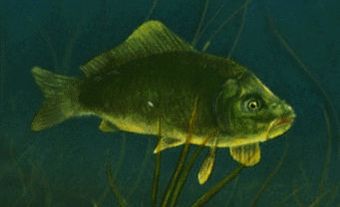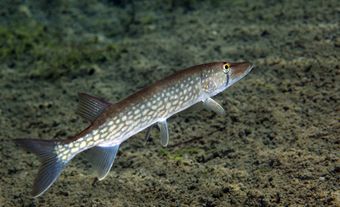
Pike is the common name for the group of 5 species of predaceous freshwater fish with elongated snouts, sharp teeth, cylindrical bodies and forked tails, belonging to family Esocidae, order Esociformes, class Actinopterygii. Northern pike (Esox lucius) is circumpolar in distribution; amur pike (E. reicherti) is native to Siberia and China; muskellunge (E. masquinongy) and pickerel (E. niger and E. americanus) are confined to N America. The northern pike occurs throughout Canada, except in the Maritimes, Gaspé, most arctic coastal areas and all but the NE corner of BC. This species inhabits warm to cool lakes, rivers and large ponds, usually in association with aquatic vegetation.
Description
The northern pike is the fish most commonly thought of as "pike." It is a large, soft-rayed fish with an oval body and a large, flattened head with duck-billed snout, well armed with large teeth. The single dorsal fin and the anal and caudal (tail) fins are close together. The northern pike is distinguished by a pattern of horizontal rows of bean-shaped, yellow spots on a green to brown background, 4-6 pores on the underside of each lower jaw, and the presence of scales over the whole of the cheeks and half of the gill covers.
Reproduction
Pike spawn in early spring (April-May); adults often move towards spawning grounds under the ice. No nest is built; no parental care is provided. Reproductive capability is achieved at 2-4 years of age. Specimens are known to exceed 24 years of age, 1-1.5 m in length and 14-20 kg in weight. The N American angler record fish, caught in 1940, was 133.3 cm long and weighed 20.92 kg. The record for Canada, caught in Saskatchewan in 1954, weighed 19.39 kg.
Diet
Pikes are lie-in-wait predators, rushing on prey from cover, capturing it sideways, then returning to cover to turn the victim around and swallow it head first. Adults eat other fishes almost exclusively.
Significance of Fishery
The northern pike is subject to cancerous lymphosarcoma and to a disease called red sore. Pike carry parasites known as yellow grub (in the flesh) and blackspot (on the skin) which cannot infect humans and are killed when the pike are properly cooked. In certain locations, pike carry the broad tapeworm, which can be transferred to humans. Northern pike is a commercial fish as well as a sport fish. It ranks second, by weight, of fish taken annually in Saskatchewan. In 1993, the total Canadian commercial harvest was 2150 t, with a value to fishermen of $1.5 million.

 Share on Facebook
Share on Facebook Share on X
Share on X Share by Email
Share by Email Share on Google Classroom
Share on Google Classroom



